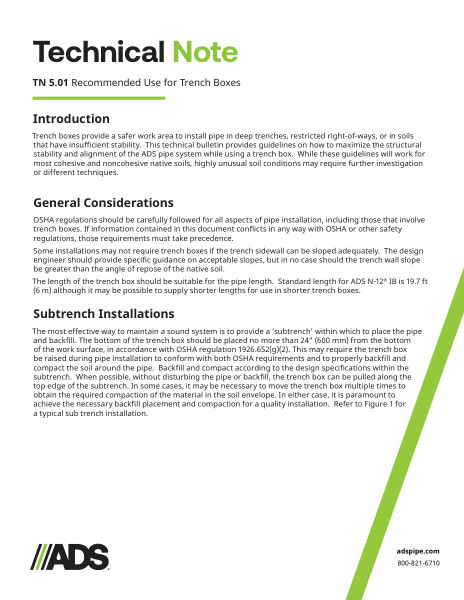TN 5.01 Recommended Use for Trench Boxes
Filename:
TN 5.01 Recommended Use for Trench Boxes.pdf

This document is the TN 5.01 Recommended Use for Trench Boxes. Subtrench installation and regular trench installations discussed.
Trench boxes provide a safer work area to install pipe in deep trenches, restricted right-of-ways, or in soils that have insufficient stability. This technical bulletin provides guidelines on how to maximize the structural stability and alignment of the ADS pipe system while using a trench box. While these guidelines will work for most cohesive and noncohesive native soils, highly unusual soil conditions may require further investigation or different techniques.
OSHA regulations should be carefully followed for all aspects of pipe installation, including those that involve trench boxes. Some installations may not require trench boxes if the trench sidewall can be sloped adequately. The design engineer should provide specific guidance on acceptable slopes, but in no case should the trench wall slope be greater than the angle of repose of the native soil. The length of the trench box should be suitable for the pipe length, although it may be possible to supply shorter lengths for use in shorter trench boxes.
The most effective way to maintain a sound system is to provide a ‘subtrench’ within which to place the pipe and backfill. Figure 1 shows the subtrench installation.
For regular trench installations not involving a subtrench situation, dragging a trench box should only be done if it does not damage the pipe or disrupt the backfill; otherwise, the box should be lifted vertically into its new position.
While trench boxes increase worker safety in difficult site conditions, their use requires some precautions be taken to ensure a structurally sound finished installation.
Construction of a subtrench is the most effective means of maintaining a sound system; the trench box can simply be pulled along the top edge of the subtrench. When a regular trench is used, techniques such as lifting the box, keeping the box about three-fourths the nominal pipe diameter up from the trench bottom, and providing a wide granular backfill envelope will help provide a quality installation.
